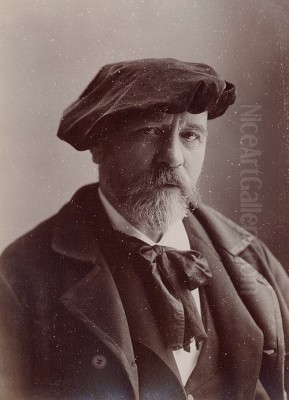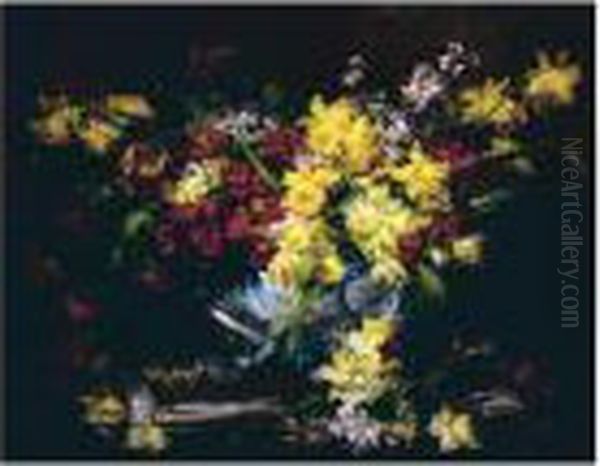
Ernest Quost (1844-1931) stands as a significant, if sometimes overlooked, figure in late 19th and early 20th-century French art. Primarily celebrated for his exquisite depictions of flowers, particularly hollyhocks, Quost carved a distinct niche for himself within the vibrant Parisian art world. His work, characterized by luminous color and delicate observation, not only earned him considerable recognition during his lifetime but also captured the attention and admiration of fellow artists, most notably Vincent van Gogh. Exploring Quost's life and career reveals an artist dedicated to the beauty of the natural world and whose influence extended subtly through the artistic currents of his time.
Early Life and Artistic Formation
Born in Avallon, France, in 1844, Ernest Quost's artistic journey began not in the traditional academic studios of Paris, but within the specialized environment of the renowned Sèvres porcelain factory. This early training proved foundational, instilling in him a deep appreciation for meticulous detail and the art of floral decoration. The discipline required for painting on porcelain likely honed his observational skills and his ability to render the delicate structures and vibrant hues of flowers, a subject that would dominate his later career.
Seeking broader artistic horizons, Quost later spent a brief period studying at the Académie Julian in Paris. This private art school was a bustling hub for aspiring artists from France and abroad, offering an alternative to the more rigid École des Beaux-Arts. While his time there was short, it placed him within the dynamic atmosphere of the Parisian art scene, exposing him to diverse influences and the ongoing debates surrounding academic tradition, Realism, and the burgeoning Impressionist movement. This period likely broadened his technical repertoire and contextualized his specialized skills within the larger landscape of contemporary painting.
The Montmartre Garden and Artistic Themes

During the 1870s and 1880s, Quost established himself in Montmartre, then still a semi-rural village on the outskirts of Paris, attracting artists with its picturesque charm and affordable living. Crucially, Quost cultivated his own garden there. This personal patch of nature became a vital source of inspiration, providing him with direct access to the floral subjects he so loved to paint. His canvases from this period often reflect this intimate connection, capturing the transient beauty of blooming flowers and the play of light across petals and leaves.
While flowers, especially hollyhocks (roses trémières), became his signature subject, Quost's artistic interests were not solely confined to still life. He also produced numerous landscapes, capturing the rustic charm of the Montmartre countryside and other pastoral scenes. These works often share the same sensitivity to light and atmosphere found in his floral paintings. His style remained versatile, encompassing detailed still lifes, evocative landscapes, and charming rural vignettes, all unified by a dedication to capturing the beauty he observed in the world around him.
Mastery of Floral Representation
It was Quost's exceptional ability to paint flowers that truly defined his reputation. He possessed a remarkable talent for conveying not just the appearance of blossoms, but also their texture, fragility, and vitality. His brushwork, often delicate yet confident, combined with a keen sense of color harmony, allowed him to create compositions that were both botanically accurate and aesthetically captivating. He excelled at capturing the effects of light, making his floral arrangements shimmer with an inner luminosity.
His particular affinity for hollyhocks became widely recognized. These tall, stately flowers, with their vibrant blooms ranging from deep reds and pinks to pale yellows and whites, offered a dramatic subject that Quost rendered with unparalleled skill. A representative work, often cited as Garden with Hollyhocks, exemplifies his mastery. It typically depicts towering stalks of pink and white hollyhocks set against a bright sky or a sun-drenched wall, the composition alive with color and light, rendered with bold yet sensitive brushstrokes over a light ground, achieving a soft, harmonious effect.
Quost and the Impressionist Milieu
Ernest Quost worked during a period of profound artistic change in France, dominated by the rise and evolution of Impressionism and Post-Impressionism. While not strictly an Impressionist himself – his work often retained a degree of detail and finish associated with more traditional approaches – his sensitivity to light, vibrant palette, and sometimes looser brushwork show an awareness of the Impressionist revolution. He shared with artists like Claude Monet a deep love for gardens as subject matter, though Monet's focus was more on capturing fleeting atmospheric effects and the overall impression of light and color.
Quost navigated the art world alongside major figures like Monet, Pierre-Auguste Renoir, Edgar Degas, and Camille Pissarro. His focus on floral still life also places him in a lineage that includes Henri Fantin-Latour, another contemporary renowned for his exquisite flower paintings, though Fantin-Latour's style was generally tighter and more formally composed. Quost's work offered a slightly different sensibility, often brighter and perhaps more decorative, reflecting his Sèvres background. He successfully found his audience and critical acclaim within this complex artistic landscape.
A Respected Figure: Salon Success and Recognition
Unlike some avant-garde artists who rejected official channels, Quost actively participated in the established art world of his time. He began exhibiting his work at the prestigious Paris Salon, the official annual art exhibition, as early as 1866. Consistent participation in the Salon was crucial for an artist's visibility and career advancement during this era.
Quost's talent did not go unnoticed. He received official recognition for his contributions, earning medals at the Salon in 1880 and 1882. Further honours followed: he was made a Chevalier (Knight) of the Legion of Honour in 1883, a significant mark of distinction in France, and was later promoted to Officier (Officer) of the same order in 1903. These accolades cemented his status as a respected and successful artist within the French cultural establishment, demonstrating that his appealing style and technical skill resonated with critics and the public alike.
The Van Gogh Connection: Hollyhocks and Sunflowers
One of the most fascinating aspects of Quost's career is his connection to Vincent van Gogh. While living in Arles, Van Gogh became aware of Quost's reputation, particularly his mastery of hollyhocks. This admiration is famously captured in a letter Van Gogh wrote to his brother Theo around August 1888 (Letter 666), where he mused on artists and their signature flowers: "You know Jeannin has the peony, Quost has the hollyhock, but I have the sunflower, in a way." This statement reveals not only Van Gogh's respect for Quost but also his own ambition to claim the sunflower as his personal emblem.
Earlier, during Van Gogh's time in Paris (1886-1888), he had encountered Quost's work more directly. In 1886, Van Gogh saw a floral still life by Quost, possibly titled Easter Flowers, at an exhibition. He was deeply impressed, describing the work as "very good" in a letter and expressing a wish that Quost would exhibit more such pieces. It's highly probable that Quost's vibrant depictions of flowers, particularly his hollyhocks, provided inspiration for Van Gogh's own intense explorations of floral subjects during his Paris period and later, influencing his approach to color and composition in works that aimed to express powerful emotions through nature. While their styles differed significantly – Van Gogh's being far more expressive and emotionally charged – Quost's success with floral themes clearly resonated with him.
Mentorship and Guidance: Nurturing Talent
Beyond his own artistic output and his indirect influence on giants like Van Gogh, Ernest Quost also played a role in nurturing the careers of other artists. He acted as a mentor and provided guidance to painters who sought his advice, demonstrating a generosity of spirit within the competitive art world.
One notable example is Pierre-Eugène Montezin (1874-1946). Early in his career, Montezin faced rejection from the Paris Salon. Discouraged, he found encouragement and practical instruction from Quost. Quost helped Montezin refine his painting techniques and likely advised him on navigating the art scene. Under Quost's guidance, Montezin persevered, eventually becoming a successful and recognized landscape painter in his own right, known for his post-impressionistic style.
Another artist who benefited from Quost's expertise was Eugène Henri Cauchois (1850-1911). Cauchois also studied with the more famous academic painter Alexandre Cabanel, but he specifically sought out Quost for advice on flower painting. Quost provided Cauchois with "special tips" that significantly influenced his development as a painter specializing in decorative floral compositions. This mentorship highlights Quost's recognized mastery in his specific field and his willingness to share his knowledge with younger artists.
Quost's Enduring Legacy
Ernest Quost passed away in Paris in 1931, leaving behind a substantial body of work dedicated primarily to the beauty of flowers and landscapes. While perhaps not as revolutionary as some of his contemporaries like Monet, Degas, or the Post-Impressionists like Paul Cézanne or Van Gogh, Quost holds a distinct and respectable place in French art history. His achievement lies in his mastery of a specific genre – floral painting – which he pursued with technical brilliance and genuine affection throughout his long career.
His legacy is twofold. Firstly, there are his paintings themselves: luminous, colourful, and exquisitely detailed celebrations of nature, particularly his signature hollyhocks. These works continue to charm viewers with their decorative appeal and technical finesse. Secondly, there is his influence, both direct and indirect. His mentorship helped shape the careers of artists like Montezin and Cauchois. More significantly, his work captured the admiration of Vincent van Gogh, serving as a point of reference and perhaps inspiration during a critical phase of Van Gogh's development. The comparison Van Gogh drew between himself, Quost, and Georges Jeannin underscores Quost's recognized preeminence as the "painter of hollyhocks."
Conclusion
Ernest Quost represents a successful artistic career built on dedication to a chosen subject and exceptional technical skill. Trained in the decorative arts and honed through observation of his own garden, he became one of the foremost flower painters of his generation. His work, appreciated at the Salon and admired by fellow artists including Van Gogh, bridged traditional sensibilities with an awareness of contemporary trends in light and colour. While the dramatic narratives of Impressionism and Post-Impressionism often dominate accounts of the era, artists like Quost played a vital role, enriching the artistic landscape with their specific talents and contributing to the broader cultural milieu through their work and their interactions within the art community. His paintings remain a testament to his love for nature's floral beauty and his significant, if quiet, influence on the art of his time.